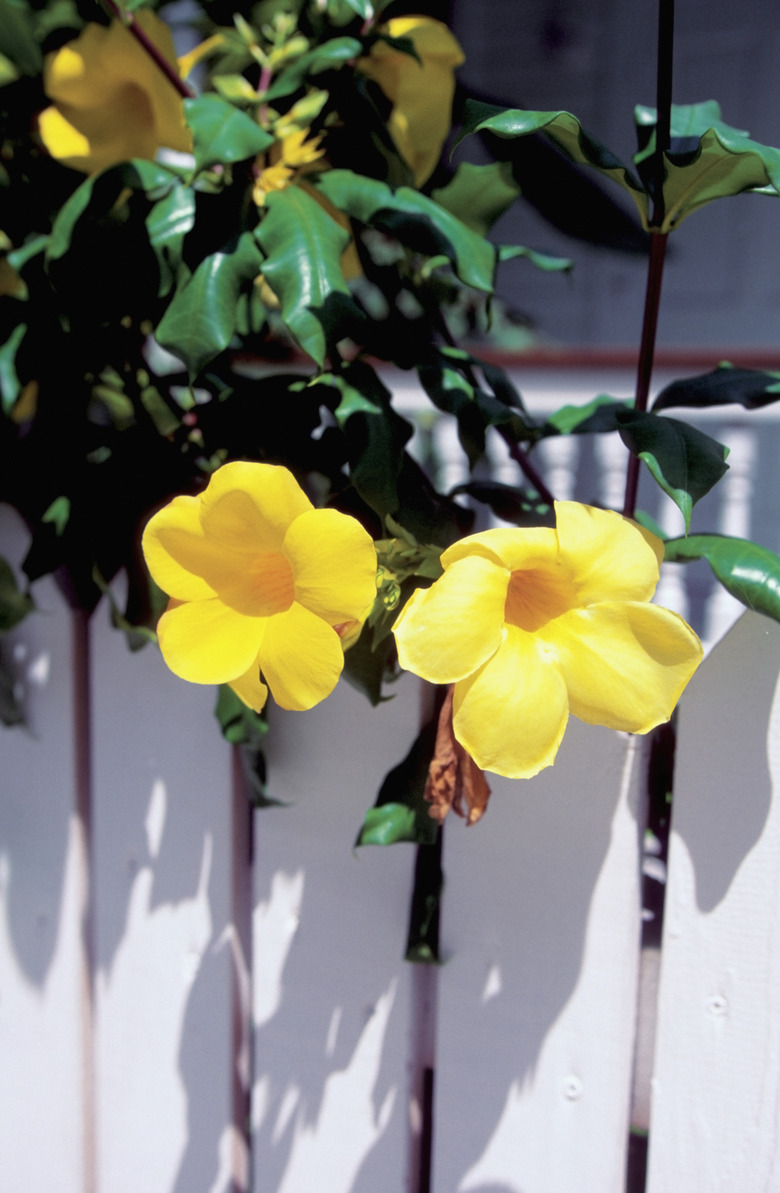Florida Vines That Cause Rashes & Itching
Florida's parks and landscapes are favored by outdoorsy types because of the wide variety of plant life that thrives there, including beautifully vibrant vines. The species of vines that grow in Florida are hardy in U.S. Department of Agriculture plant hardiness zones 9 through 11, and some of these are poisonous. Just touching certain Florida vines can lead to skin rashes and itchiness.
Poison Ivy
Step 1
Poison ivy (Toxicodendron radicans) is hardy in USDA hardiness zones 3 through 10 and features leaflets that occur in groups of three and hair-like aerial rootlets that grow out of the stem and are used to climb. Poison ivy's white berries grow in clusters and are eaten by birds, and its leaves turn red and purple in the fall. The sap of this vine contains an oily resin called urushiol, which is found in the leaves, stems and roots, and typically causes a red rash that is itchy and may include swelling and blisters. It takes about 2 or 3 days after contact for the rash to develop, and symptoms typically last 2 to 3 weeks. Poison ivy rash doesn't usually require medical attention. However, burning the vines should be avoided because the smoke from burning poison ivy vines can irritate the lungs.
- Florida's parks and landscapes are favored by outdoorsy types because of the wide variety of plant life that thrives there, including beautifully vibrant vines.
- However, burning the vines should be avoided because the smoke from burning poison ivy vines can irritate the lungs.
Japanese Honeysuckle
Step 1
Japanese honeysuckle (Lonicera japonica) is hardy in USDA zones 4 through 10. This trailing, twining vine is evergreen in warm climates like Florida's, and it is considered invasive in many U.S. states because of its vigorous growth. However, it is prized by some home gardeners for its fragrant pale pink and yellow tubular flowers and shiny black berries. Its dark green leaves contain a sap that can be irritating to the skin. Both the leaves and berries are also poisonous if ingested. Contact the National Poison Control Center at 1-800-222-1222 or your local emergency services if you suspect ingestion of this plant.
Virginia Creeper
Step 1
Virginia creeper (Parthenocissus quinquefolia) is a climbing vine that is hardy in zones 3b through 10 and is prized by home gardeners for its dark blue berries and green foliage that turns red in the fall. This vine contains oxalic acid, and touching its leaves in the fall can cause dermatitis for some people, although the real danger with this plant occurs when ingested. The berries can cause nausea, stomach pain, diarrhea and bloody vomit. Contact the National Poison Control Center or your local emergency services if you suspect ingestion of this plant.
- Japanese honeysuckle (Lonicera japonica) is hardy in USDA zones 4 through 10.
- This vine contains oxalic acid, and touching its leaves in the fall can cause dermatitis for some people, although the real danger with this plant occurs when ingested.
Carolina Jasmine
Step 1
Carolina jasmine (Gelsemium sempervirens), also referred to as yellow jessamine, is a twining vine native to Florida and other States, including Virginia and Texas. It is hardy in USDA zones 7 through 10, and prized by home gardeners for its fragrant, bright yellow flowers and its small evergreen leaves. However, all parts of this vine are poisonous. The sap of this plant may cause dermatitis or skin rash and if ingested, Carolina jasmine may cause serious illness. Contact the National Poison Control Center or your local emergency services if you suspect ingestion of this plant.
Trumpet Creeper
Step 1
The Trumpet Creeper (Campsis radicans) is hardy in USDA zones 4 through 9. Its tubular red to orange flowers are prized by homeowners and attract hummingbirds and butterflies. The compound leaves of this vine grow in pairs on opposite sides of the vine. The tan bark tends to peel on older vines. Trumpet vine is a woody, clinging vine that attaches itself to structures, climbing by aerial rootlets. It is also referred to as cow-itch vine because contact with the leaves can cause skin redness and itching.
- Carolina jasmine (Gelsemium sempervirens), also referred to as yellow jessamine, is a twining vine native to Florida and other States, including Virginia and Texas.
- It is also referred to as cow-itch vine because contact with the leaves can cause skin redness and itching.
References
- National Gardening Association: USDA Hardiness Zone Finder
- University of Florida Extension: Florida-Friendly Landscaping Pattern Book
- Florida Poison Information Center – Tampa: Common Poisonous Plants of Florida
- Floridata: Vicious, Vigorous and Vibrant Vines
- Florida Agricultural and Mechanical University: Identifying Poisonous Plants
- Floridata: Toxicodendron Radicans
- Mayo Clinic: Poison Ivy Rash
- University of California: Safe and Poisonous Garden Plants: Toxic Plants (By Common Names)
- Floridata: Lonicera Japonica
- Ohio State University Extension: Ohio Perennial and Biennial Weed Guide: Virginia Creeper
